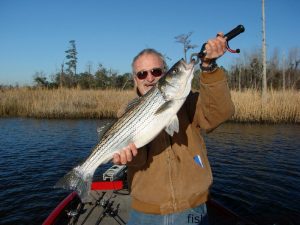Wrightsville Beach March 8, 2012

David Jackson landed this 40 lb. wahoo while trolling near the Nipple in 200' of water. The 'hoo struck a ballyhoo under a Blue/Silver Ilander while he was fishing with Capt. Mike Jackson of Live Line Charters.
Arlen, of Tex’s Tackle, reports that the mild winter has led some good inshore action all winter long. Anglers are finding action with speckled trout and red drum in the backwaters of area creeks, with the most activity in the shallows (<3’). Scented soft plastic baits, like Gulps, and other soft plastics with scents, like Pro-Cure Super Gel, added have been producing action with both fish, and Yo-Zuri’s new 3D Shrimp hardbait has also been effective.
There’s also been a decent red drum bite around some area docks. When the soft baits aren’t working, live mud minnows and chunks of mullet have been tempting bites from the dock drum.
Some black drum are feeding around inshore structure and in the surf, and shelled shrimp on bottom rigs are attracting their attention.
Some schools of red drum have also been reported in the surf zone, but they haven’t been as numerous as in previous years, likely due to the warmer winter.
Nearshore, black sea bass are so numerous it’s difficult to get away from them, but they’re closed to harvest. Some tautog are holding on the nearshore artificial reefs, but it’s tough to get a bait past the bass to get them to bite. Sand fleas, cut baits, and small jigs are effective on the ‘togs if anglers can get them past the bass.
Some false albacore and king mackerel are feeding in the vicinity of Frying Pan Tower, but they’ve been scattered lately. Trolling cigar minnows, Drone spoons, or diving plugs will tempt bites from both fish when anglers can find them.
It’s been difficult to get offshore due to the weather lately, but the wahoo and blackfin tuna are on the feed in the Gulf Stream when boats can get to them. A few yellowfin tuna and gaffer dolphin have been mixed in, and the best bite’s been around the Same Ol’ and the Nipple in around 30 fathoms lately. Conventional trolling with skirted ballyhoo and high-speed trolling have both been effective on the wahoo lately.
Frank, of Intracoastal Angler, reports that anglers are still catching a few speckled trout in the creeks and around the Masonboro Jetty. Soft plastic lures or suspending hard baits will tempt bites from the specks.

Bob Rainey, of Wilmington, with a striped bass he caught and released in the Cape Fear River after it struck a hand tied jig.
There’s been a good red drum bite beneath docks around Wrightsville recently. If anglers can find some fish that haven’t seen much pressure, they may be able to tempt them to bite Gulp baits or other soft plastics. Cut and live baits are proving more effective on the fish at well-trafficked docks.
A few flounder have been mixed in with the trout and drum, and they’re falling for the same baits. With the unseasonably mild winter, anglers are hoping to see an early and excellent flounder bite this spring.
Commercial king mackerel fishermen are starting to see some Atlantic bonito in the 40-50 mile range, and it won’t be long until they make a move toward the beach, where they’ll be feeding around nearshore structure like the artificial reefs. Trolling Yo-Zuri Deep Divers or casting small metal jigs at fish feeding on the surface is the way to hook up with the bonito.
When boats have been able to make it to the Gulf Stream lately, there’s been an excellent blackfin tuna bite for anglers working vertical jigs and topwater poppers.
Wahoo are also feeding along the break and will take an interest in trolled ballyhoo and skirted lures, and anglers may even see some yellowfin tuna when the seas lay down enough to get out.
Rick, of Living Waters Guide Service, reports that blackfin tuna and wahoo are feeding wherever warmer water is crossing the break offshore. When the winds die down enough to make the long run, anglers have been hooking both fish while trolling traditional offerings, like ballyhoo/lure combinations and diving plugs, and on lighter tackle while casting and jigging. Long metal jigs and topwater plugs are top choices for the blackfins, and lures like Blue Water Candy Mama Jamas and Jag-A-Hoos are attracting attention from the wahoo.
Vertical jigging at spots to the north along the break is producing plenty of action with amberjacks. African pompano, cobia, groupers, and more will also fall for the jigs.
The commercial fleet has found up-and-down action with king mackerel in the 40-50 mile range in recent weeks. Trolling cigar minnows and Drone spoons or other lures in mid-upper 60’s water temperatures is the way to put the kings in the boat for anglers making the run.

David Whitman, of Wilmington, with a 4 lb., 10 oz. speckled trout that bit a MirrOlure in Masonboro Inlet.
Danny, of 96 Charter Company, reports that the striped bass are still feeding in the Cape Fear River. The bite has been up-and-down, with some days producing consistent action and others requiring more work to find the fish. Trolling diving plugs like the Yo-Zuri Deep Divers and Mann’s Stretch Series is one way to locate the action. Once anglers have found some feeding fish, they can slow down and cast soft plastics or work suspending hardbaits to tempt the stripers to bite.
Both casting and trolling have been producing some interesting surprises in the river lately, including speckled trout, puppy drum, and an occasional catfish (some over 20 lbs.).
Justin, of Johnnie Mercer’s Pier, reports that anglers are picking up some dogfish at night and a few pufferfish during the day. Shrimp on bottom rigs will tempt bites from both.
The water is 58 degrees, so it shouldn’t be long until the sea mullet, black drum, and bluefish join in on the action.
